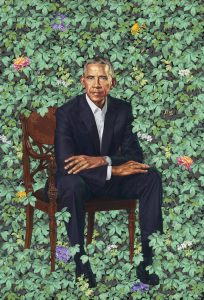 Noted early twentieth century cultural signifier Eau de Nil wends it way from Flaubert in Egypt to Hitchcock to a fresh moment in the sun thanks to a cool president’s new portrait:
Noted early twentieth century cultural signifier Eau de Nil wends it way from Flaubert in Egypt to Hitchcock to a fresh moment in the sun thanks to a cool president’s new portrait:
The term first entered our chromatic lexicon in the late nineteenth century, just as Egyptomania was hitting its peak. While in the British Isles talk of “the East” referred primarily to India, France had a particularly strong affinity for Egypt—due in part to Napoleon’s brief 1798 attempts at colonization and the influence of the savants. “If you were French,” Wall writes, “the east was Egypt, a place at the very limit of the European imagination … Egypt was the orient, a country of the mind, a grand theatre of sensuality, despotism, slavery, polygamy, cruelty, mystery and terror.” This Egypt of the mind had little reality outside the poetry of Keats and Shelley; the paintings of Jean-Léon Gérôme, Emile Bernard, and André Duterte (whose painting of the ruined temple at Thebes may have been the basis for “Oxymandias”); and the oddly popular theories of the occultist Helena Blavatsky and her follower, the “wickedest man in the world,” Aleister Crowley. For the French, Egypt as a concept was far more exciting than Egypt as an actual place. (Though not to Flaubert; to him, Egypt was where he bedded nubile young women after watching them dance the popular striptease, “the bee.”)
Image: the great portrait by Kehinde Wiley
